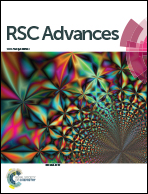Tannic acid anchored layer-by-layer covalent deposition of parasin I peptide for antifouling and antimicrobial coatings†
Abstract
Tannic acid can serve as an initiator anchor for surface functionalization. Parasin I is an antimicrobial peptide derived from histone. Multilayer coatings on stainless steel were prepared by alternative deposition of these two materials via the Michael addition/Schiff base reaction-enabled layer-by-layer (LBL) deposition technique. The as-prepared multilayer coating exhibits good resistance to Gram-negative bacteria (Pseudomonas sp. and E. coli), Gram-positive bacteria (S. aureus and S. epidermidis) and microalgae (Amphora coffeaeformis). The antifouling and antimicrobial efficacy increase with an increasing number of the assembled multilayers. The stability and durability of multilayer coatings were also ascertained by prolonged exposure to seawater. The LBL covalently deposited multilayer coatings are thus potentially useful as effective and environmental benign coatings to combat biofouling in marine and aqueous environments.


 Please wait while we load your content...
Please wait while we load your content...